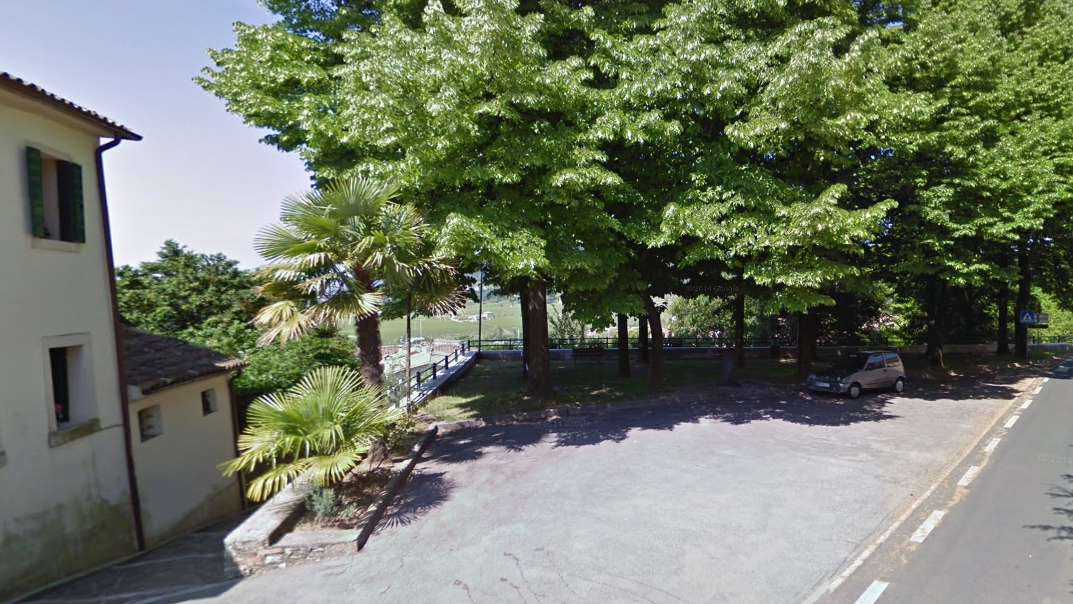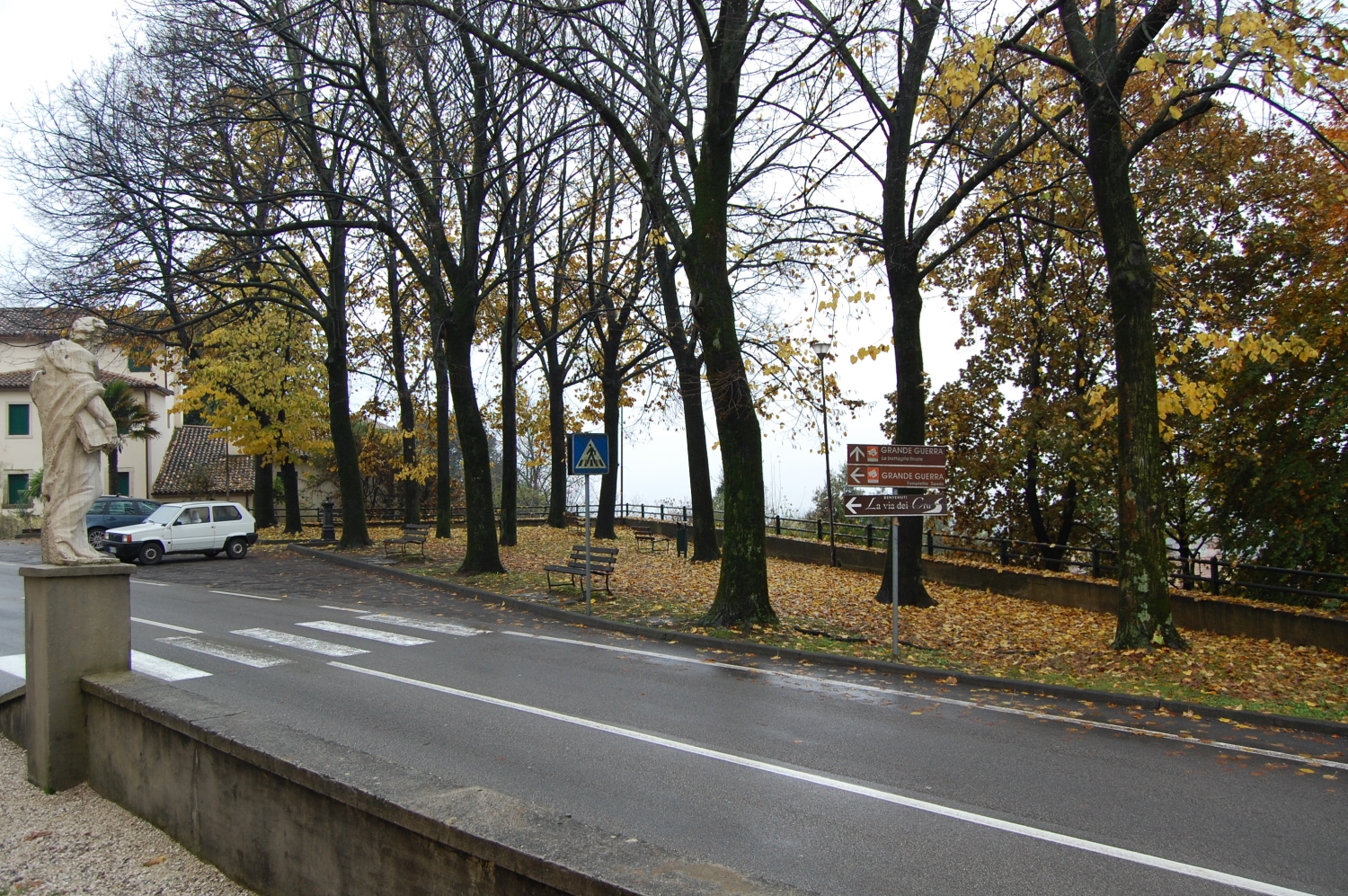Piazza Abate Capretta e il Belvedere
 Belvedere
Belvedere
Descrizione
La piazzetta antistante la chiesa del paese è dedicata all’Abate Capretta. Da qui, nelle belle giornate, si può avere un’ampia immagine del Quartier del Piave, che è il pianoro delimitato a sud dal fiume Piave e a nord dai rilievi collinari che caratterizzano l'alta Marca Trevigiana: s’individuano le colline di Collalto, del Montello e le colline che da Vidor fino a Refrontolo chiudono la parte pianeggiante che appare diffusamente urbanizzata. I paesi principali sono localizzabili grazie ai campanili delle loro chiese: si possono così identificare i paesi di Pieve di Soligo, Solighetto, Soligo, Sernaglia e Falzè di Piave.
L’ampio Belvedere sul Quartier del Piave e sugli obiettivi strategici del fiume Piave e del Monte Grappa sono all’origine dell’invasione nemica nel 1917 e l’occupazione della Villa Spada. Dopo la disfatta di Caporetto Refrontolo venne a trovarsi in zona di guerra e fu testimone delle pagine conclusive di quel tragico capitolo di storia italiana.
Poco dopo mezzogiorno di venerdì 9 novembre 1917 arrivarono due ufficiali austriaci a cavallo . Verso le due compaiono le prime truppe dell’esercito tedesco. Alle sei entra in Villa Antonietta, oggi denominata Villa Spada, il Primo Comando germanico, una ventina di ufficiali e 150 soldati con cavalli, biciclette, motociclette. Anche la chiesa venne occupata e il 22 novembre Refrontolo è invasa da migliaia di automobili, autocarri, cavalli e truppe.
The little square in front of the church is dedicated to Abbot Capretta. From here, on clear days, you can enjoy an extensive view of the area Quartier del Piave, the plateau bounded to the south by the river Piave and to the north by the hills of the Alta Marca Trevigiana area. You can see the hills of Collalto, of Montello and those which, from Vidor to Refrontolo, enclose the flatter land that is more heavily built up. The main villages, which can be identified by their church bell towers, are Pieve di Soligo, Solighetto, Soligo, Sernaglia and Falzè di Piave.
The view over the Quartier del Piave area and the strategic objectives of the Great War that were the river Piave and Monte Grappa sparked the enemy invasion of 1917 and the occupation of Villa Spada. After the rout that was the Battle of Caporetto, Refrontolo found itself in a war zone and bore witness to the final stages of this tragic chapter of Italian history.
A little after midday on Friday 9 November 1917, two Austrian officers arrived on horseback. At about two o’clock the first troops of the German army arrived. At six o’clock Villa Antonietta, today called Villa Spada, was entered by the German High Command with about twenty officers and 150 soldiers on horseback, bicycles and motorbikes. Even the church was occupied and on 22 November Refrontolo was invaded by thousands of cars, truck, horses and troops.
Der Vorplatz der Pfarrkirche des Ortes wurde nach dem Abt Capretta benannt. Von hier aus hat man an schönen Tagen eine weiträumige Aussicht auf das Quartier del Piave, eine Hochebene, die im Süden vom Fluss Piave und im Norden von Hügeln begrenzt ist und die obere Marca Trevigiana charakterisiert: Man erblickt die Hügel von Collalto, Montello und die Erhebungen, die von Vidor bis Refrontolo die weitläufig besiedelte Ebene begrenzen. Die wichtigsten Ortschaften sind an den Glockentürmen ihrer Kirchen erkennbar: Man sieht die Ortschaften Pieve di Soligo, Solighetto, Soligo, Sernaglia und Falzè di Piave.
Der Aussichtspunkt auf Quartier del Piave und die strategischen Ziele am Fluss Piave und auf dem Monte Grappa spielten im Jahre 1917 eine wichtige Rolle bei der feindlichen Invasion und der Besetzung von Villa Spada. Nach der Niederlage von Caporetto war Refrontolo ein Schauplatz des Krieges und Zeuge der letzten Geschehnisse dieses tragischen Kapitels der italienischen Geschichte.
Am 9. November 1917 erreichten kurz nach Mittag zwei berittene österreichische Offiziere den Ort. Gegen zwei Uhr erschienen die ersten Truppen des deutschen Heers. Um sechs betrat das deutsche Oberkommando - etwa zwanzig Offiziere und 150 Soldaten mit Pferden, Fahr- und Motorrädern - Villa Antonietta, heute als Villa Spada bekannt. Auch die Kirche wurde besetzt, und am 22. November war Refrontolo von unzähligen Autos, Lastzügen, Pferden und Truppen überschwemmt.


